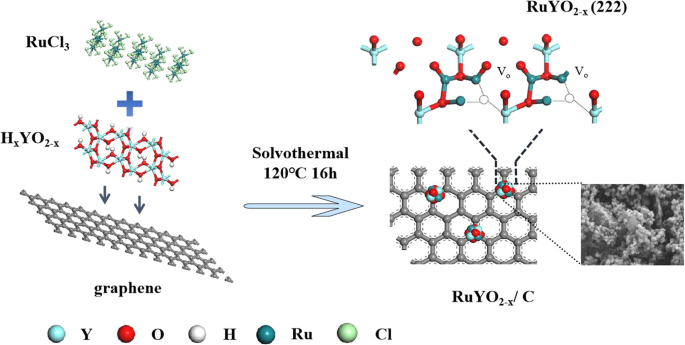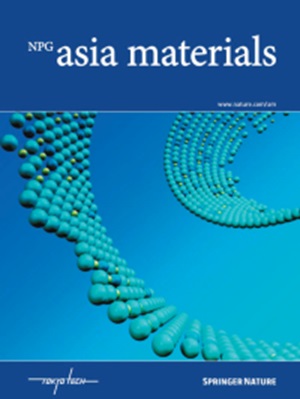Implanting HxYO2−x sites into Ru-doped graphene and oxygen vacancies for low-overpotential alkaline hydrogen evolution
IF 8.3
2区 材料科学
Q1 MATERIALS SCIENCE, MULTIDISCIPLINARY
引用次数: 0
Abstract
Highly efficient electrocatalysts for the hydrogen evolution reaction (HER) are essential for sustainable hydrogen energy. The controllable production of hydrogen energy by water decomposition depends heavily on the catalyst, and it is extremely important to seek sustainable and highly efficient water-splitting electrocatalysts for energy applications. Herein, bimetallic RuYO2−x nanoparticles (Ru: 8.84 at.% and Y: 13 at.%) with high densities and low loadings were synthesized and anchored on graphene through a simple solvothermal strategy by synthesizing hydrogen yttrium ketone (HxYO2−x) serving as an inserted medium. Electron microscopy demonstrated that the RuYO2−x/C was composed of densely arranged particles and graphene flakes. Electrochemical results showed that the RuYO2−x/C had a remarkably low overpotential of η10 = 56 mV at a current density of 10 mA cm−2 in alkaline media, a Tafel slope of 63.18 mV dec−1, and 24 h of stability. The oxygen vacancies of RuYO2−x/C provided a large proton storage capacity and a strong tendency to bind hydrogen atoms. DFT calculations showed that RuYO2−x/C catalysts with more Ru-O-Y bonds and VO dramatically decreased the energy barrier for breaking H-OH bonds. Moreover, the robust metal-support interactions provided optimized energies for hydrogen adsorption and desorption, which explained the high activity and favorable kinetics for RuYO2−x/C catalytic hydrogen precipitation in alkaline electrolyte reactions. This work presents a hydrogen insertion method for the preparation of low-loading, high-density, high-performance and stable water decomposition catalysts for hydrogen production. We present a strategy for significantly increasing the H contents on catalysts for the HER in alkaline electrolyte solutions, which were generated by combining ruthenium with HxYO2−x on an oxygen vacancy-rich graphene system. This strategy greatly increased the hydrogen coverage on the RuYO2−x/C catalyst to enhance the HER performance.


在钌掺杂石墨烯和氧空位中植入HxYO2−x位用于低过电位碱性析氢
高效的析氢反应电催化剂是实现可持续氢能的必要条件。水分解氢能源的可控生产在很大程度上依赖于催化剂,寻求可持续、高效的水分解电催化剂对能源应用至关重要。本文制备了双金属RuYO2−x纳米粒子(Ru: 8.84 at。通过简单的溶剂热策略,通过合成氢钇酮(HxYO2−x)作为插入介质,合成了高密度和低负载的氢钇酮(Y: 13 at.%)并锚定在石墨烯上。电镜观察表明,RuYO2−x/C由密集排列的颗粒和石墨烯薄片组成。电化学结果表明,在碱性介质中,当电流密度为10 mA cm−2时,RuYO2−x/C的过电位为η10 = 56 mV, Tafel斜率为63.18 mV dec−1,稳定性为24 h。RuYO2−x/C的氧空位提供了大的质子存储容量和强的结合氢原子的倾向。DFT计算表明,含有较多Ru-O-Y键和VO的RuYO2−x/C催化剂显著降低了H-OH键断裂的能垒。此外,强大的金属-载体相互作用为氢的吸附和解吸提供了优化的能量,这解释了在碱性电解质反应中RuYO2−x/C催化氢沉淀的高活性和良好的动力学。提出了一种低负荷、高密度、高性能、稳定的水分解制氢催化剂的插氢方法。我们提出了一种在碱性电解质溶液中显著增加HER催化剂上H含量的策略,该策略是通过在富氧空位的石墨烯体系上将钌与HxYO2−x结合而产生的。该策略大大增加了RuYO2−x/C催化剂上的氢覆盖率,从而提高了HER性能。
本文章由计算机程序翻译,如有差异,请以英文原文为准。
求助全文
约1分钟内获得全文
求助全文
来源期刊

Npg Asia Materials
MATERIALS SCIENCE, MULTIDISCIPLINARY-
CiteScore
15.40
自引率
1.00%
发文量
87
审稿时长
2 months
期刊介绍:
NPG Asia Materials is an open access, international journal that publishes peer-reviewed review and primary research articles in the field of materials sciences. The journal has a global outlook and reach, with a base in the Asia-Pacific region to reflect the significant and growing output of materials research from this area. The target audience for NPG Asia Materials is scientists and researchers involved in materials research, covering a wide range of disciplines including physical and chemical sciences, biotechnology, and nanotechnology. The journal particularly welcomes high-quality articles from rapidly advancing areas that bridge the gap between materials science and engineering, as well as the classical disciplines of physics, chemistry, and biology. NPG Asia Materials is abstracted/indexed in Journal Citation Reports/Science Edition Web of Knowledge, Google Scholar, Chemical Abstract Services, Scopus, Ulrichsweb (ProQuest), and Scirus.
 求助内容:
求助内容: 应助结果提醒方式:
应助结果提醒方式:


